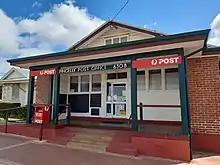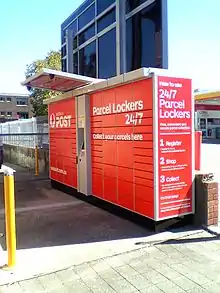Australia Post
Australia Post, formally the Australian Postal Corporation, is the government business enterprise that provides postal services in Australia. The head office of Australia Post is located in Bourke Street, Melbourne, which also serves as a post office.
 | |
| Industry | Postal service |
|---|---|
| Predecessor | Postmaster-General's Department |
| Founded | 1 July 1975 |
| Headquarters | , |
Number of locations | 4,429 metropolitan retail outlets[1] 2,561 retail outlets in rural & remote areas[1] |
Area served | Australia |
Key people | Lucio Di Bartolomeo (Chairman of the Board) Rodney Boys (Acting CEO) |
| Products | Postal services, Digital Services, Retail, Express post, Logistics, Printing Services |
| Revenue | |
| Owner | Australian Government |
Number of employees | 32,732 (2013)[1] |
| Website | auspost |
Australia Post is the successor of the Postmaster-General's Department, which was established at federation in 1901 as the successor to colonial post services. In 1975, the department was abolished and its postal functions were taken over by the Australian Postal Commission.[4] The organisation's current name and structure were adopted in 1989 as part of a process of corporatisation.
History
Colonial Australia (pre-1901)
.jpg.webp)
Before colonial control of mail started in 1809, mail was usually passed on by ad hoc arrangements made between transporters, storekeepers and settlers. These arrangements were flexible, and inherently unstable. It was common for early settlers to ride many miles out of their way to deliver neighbours' mail that had been collected from informal distribution points.[5]
The first organisation of a postal service in Australia commenced in 1809 with the appointment in Sydney of the first postmaster. An English ex-convict, Isaac Nichols, took the post operating from his home in George Street, Sydney. His main job was to take charge of letters and parcels arriving by ship, to avoid the chaos of people rushing aboard ships as soon as they arrived at Sydney's wharves. Nichols would pick up the mail and post a list of recipients outside his house.[6] He would advertise in the Sydney Gazette the names of all those who received mail. Recipients paid a fixed price of one shilling per letter to collect mail from Nichols' home, with parcels costing more depending on how heavy they were. VIP addressees were afforded personal delivery by Nichols.[7]
Between 1812 and 1842, postmasters were also appointed in Tasmania (1812), Western Australia (1829), Victoria (1836), South Australia (1837), and Queensland (1842). Settlements outside of the postmasters' domain were serviced by contractors on horsebacks or in coaches.[8]
In 1825, the New South Wales Legislative Council passed the Postal Act which transferred responsibility from Nichols, acting as a private company, to the governor. The governor would then set the wage of the postmaster and the cost of collecting mail.
1900s
Following federation in 1901, the colonial mail systems were merged into the Postmaster-General's Department (PMG). This body was responsible for telegraph and domestic telephone operations as well as postal mail. An airmail service was introduced in 1914.[7] In 1967, 4-digit postcodes in Australia were introduced, in addition to the world's first mechanical processing centre, which garnered international attention.[9]
On 1 July 1975, separate government commissions were created to undertake the operational responsibilities of the PMG. One of these was the Australian Postal Commission. It later became the Australian Postal Corporation on 1 January 1989 when it was corporatised into what is now known as the Australian Postal Corporation, or Australia Post.
2000s
Under amendments to the Australian Postal Corporation Act which came into effect in March 2008, quarantine inspection officers of a state or territory are authorised to request Australia Post to open packets and parcels sent from interstate for inspection when inspectors believe they may contain quarantine material. The legislation also authorises Australia Post to remove any mail articles that are suspected of being scam mail.[10]
In February 2010, Ahmed Fahour was appointed MD and CEO of Australia Post.[11] In May 2010, he announced a new strategy dubbed "Future Ready" designed to reinvigorate Australia Post. This included a new organisation structure as well as a renewed foray into digital businesses under the "eServices" Strategic Business Unit.[12]
However, in 2013, the corporation acknowledged that, though the strategy was successful in improving Australia Post's profitability and structure, it was insufficient in its contributions to their development as a financially self-sustaining business.[13]
In September 2015, the corporation announced its first loss in 30 years. The A$222 million loss was down from a $116 million profit the previous year. Large decreases in addressed and stamped mail led to a $381 million loss in the mail delivery side of the business. Parcel delivery then accounted for over half of total revenue. Overall revenue was stable at $6.37 billion.[3]
In August the following year, Australia Post returned to profit with strong parcel and courier performance, and organisation re-structuring. However, mail performance reached an all-time low.
In February 2017, Australian Prime Minister Malcolm Turnbull criticised CEO Ahmed Fahour's $5.6 million annual salary, saying "As the Prime Minister and a taxpayer, I've spoken to the chairman today. I think that salary, that remuneration, is too high."[14] On 23 February 2017, Fahour announced his resignation, effective July 2017, telling media that the decision was not related to discussion of his salary.[15]
In October 2019, Australia Post completed a major rebranding project with Melbourne-based brand strategy firm Maud. This project saw the development of a new brand identity, website and self-service platform, parcel and letter packaging, street posting boxes, staff uniforms, and a fleet of custom-designed electric vehicles, amongst others.[16]
Operational development



Responding to competitive pressures, Australia Post continued to broaden its product and service range in 2019, having invested in extensive technology-based infrastructure programmes.[17] It operates in three core areas: letters and associated services; retail merchandise and agency services; and parcels and logistics. It has a number of subsidiaries and joint ventures, including Sai Cheng Logistics International—a joint-venture logistics company[18] established with China Post in 2005.
Australia Post operates regular mail delivery as well as an express/courier service through Messenger Post (Now trading as Startrack Courier).[19] It delivers mail every day of the week.
Australia Post is self-funding and uses its assets and resources to generate profits, which can be reinvested in the business or returned as dividends to its sole shareholder, the Australian Government. Under its community service obligations, Australia Post is committed to providing an accessible, affordable and reliable letter service for all Australians wherever they reside. The corporation reaches more than 10 million Australian addresses; operates 6,990 postal outlets;[1] and serves more than a million customers in postal outlets every business day. When the basic domestic letter rate was increased to $1.00 on 4 January 2016,[20] there were no changes to prices of concession stamps or seasonal greeting stamps, which remained at 60 cents and 65 cents respectively. At the same time, a category of "Priority" mail was introduced (as distinct from "Regular"), under which delivery standards were varied and a 50-cent Priority label was required as additional payment for the better standard.[21]
Under the Australian Postal Corporation Act 1989, letters up to 250 grams are reserved to Australia Post – other people and businesses can only carry them if they charge four times the basic postage rate. All of the other goods and services provided by Australia Post are sold in fully competitive markets and, in 2005–06, nearly 90 per cent of the corporation's profit (from ordinary activities before net interest and tax) came from selling products and services in competitive markets.
Organisational structure and information
Board of directors
- Lucio Di Bartolomeo (Chairman)[22]
- Christine Holgate (Managing Director & Group CEO) [Resigned on 2/11/2020]
- Andrea Staines (Deputy Chair)
- Mario D'Orazio
- Bruce McIver
- Tony Nutt
- Michael Ronaldson
- Jan West
- Deidre Willmott
Employment
Empty cells have no data available for that year. All results as at 30 June of the year indicated.
| Year | Full-time staff | Part-time staff | Other staff | Source |
|---|---|---|---|---|
| 1993 | 31934 | 3999 | [23] | |
| 1994 | 31130 | 4204 | 5626 | [24] |
| 1995 | 31621 | 4501 | 5253 | [25] |
| 1996 | 32040 | 5689 | 7849 | [26] |
| 1997 | 31111 | 6185 | 8466 | [27] |
| 1998 | 29564 | 6961 | 9151 | [28] |
| 1999 | 28205 | 6756 | 9776 | [29] |
| 2000 | 26915 | 8482 | 9455 | [30] |
| 2001 | 27079 | 8458 | 9660 | [31] |
| 2002 | 26950 | 8812 | 9703 | [32] |
| 2003 | 26394 | 9033 | 9557 | [33] |
| 2004 | 26019 | 9030 | 9559 | [34] |
| 2005 | 25851 | 8953 | 9570 | [35] |
| 2006 | 25387 | 9196 | 6415 | [36] |
| 2007 | 25026 | 9498 | 6247 | [37] |
| 2008 | 25093 | 9936 | [38] | |
| 2009 | 25149 | 10360 | 8106 | [39] |
| 2010 | 24205 | 10252 | [40] | |
| 2011 | 23369 | 10103 | [41] | |
| 2012 | 23221 | 9810 | [42] | |
| 2013 | 23526 | 8938 | [43] | |
| 2013 | 27315 | 8613 | [44] | |
| 2014 | 27098 | 8195 | [45] | |
| 2015 | 27098 | 8195 | [46] | |
| 2019 | 27785 | 7316 | [47] |
Job cuts
In June 2015 Australia Post announced that in view of mounting losses, and especially the accelerating decline in its letter delivery service, it would reduce its workforce by 1,900 over three years through voluntary redundancies. At the time, mail delivery losses were approaching $500 million for the 2014–15 financial year.[48]
Facts and statistics
Nationwide there are 7,950 postal routes serviced by 10,000 "posties". Motorcycles (including the Honda CT110) are used for delivery on about 6,600 routes, bicycles on 350 routes and walking for 1,000 routes. Electric-assisted bicycles were introduced in Victoria in 2011.[49] Cars, trucks and vans are used on only the longest routes. Until the 1960s the longest, and the world's longest, overland mail route was Meekatharra to Marble Bar, Western Australia. As there were few roads, a round trip took seven days. The current longest overland route is Norseman, Western Australia to Border Village, South Australia: 1,460 km (910 mi). The longest air service delivers to remote communities in the outback covering 1,790 km (1,110 mi) over two days. The last remaining mailboat service operates still on the Hawkesbury River to the north of Sydney, out of Brooklyn - The Riverboat Postman.
_SWB_van%252C_Australia_Post_(2018-11-22).jpg.webp) An Australia Post van
An Australia Post van A "postie" delivering mail on bike
A "postie" delivering mail on bike Electric scooters have been introduced in more recent years
Electric scooters have been introduced in more recent years
The most isolated Post Office is located 217 km (135 mi) from Onslow, Western Australia, 32 km (20 mi) from the nearest customer. The highest Post Office is located in Perisher Ski Resort at 1720m above sea level.
According to the 2019 Annual Report, Australia Post:
- delivered 40 million parcels in December (a new record);
- generated revenue of $6.99 billion;
- earned profit (before tax) of $41.1 million;
- saved over $250 million (business efficiency savings);
- obtained complete ownership of Australia Post Global (APG);
- domestic parcel growth reached a revenue of up to 9.2%;
- still owns StarTrack;
- delivers to 214 countries.
and had:
- over 4,342 post offices, over 2,529 in rural and remote areas
- over 15,037 street posting boxes
- approximately 80,000 people in the workforce
Undelivered items go to the mail redistribution centres, which attempt to return the items to their senders.
In February 2015, Australia Post reported a 56% fall in its half-year profit from 2014, a loss of A$151m. The first full-year loss in over 30 years was forecast. Managing Director, Ahmed Fahour noted this tied in with a worldwide decline of letter volumes over the past seven years.[50]
In February 2017 it was reported Fahour's reforms reduced potential 2015-16 losses, to A$138 million.[51]
Products and services
Australia Post operates in three core markets: letters and associated services; agency services and retail merchandise; and parcels and logistics that span both domestic and international markets.
Letters and associated services
Australia Post collects, processes and distributes letters for the entire Australian community and between Australia and other countries overseas. It also offers bulk mail delivery services for businesses and community organisations and provides research, advice, consumer list rental, and profiling and segmentation services to help businesses target their objectives and customers, along with other associated services.
Postal services

While postal services of letters and parcels are one of the original areas of Australia Post, it has also diversified its operations into the provision of other services including agency services, business-to-business integration and logistics and supply chain management (see below).
Basic domestic
The basic postage rate for a small letter has increased over the years due to inflation but influenced in recent years by a complex interplay between Australia Post's monopoly over small items, and need to provide service to all Australian addresses at the mandated basic rate.
In July 2009, Australia Post requested the Australian Competition and Consumer Commission (ACCC) to approve a stamp price rise in 2010 to 60 cents but the ACCC declined the approval of the price rise, however in April 2010, Australia Post resubmitted the proposed postal stamp rise. The ACCC approved this request on 28 May 2010 and it was published in the Government Gazette on 9 June 2010.[52][53][54]
On 26 December 2013, due to the heavy decline in mail usage due to competition from email, etc., Australia Post requested an increase in the base rate to 70c.[55]
On 4 January 2016, due to the heavy decline in mail usage due to competition from email, etc., Australia Post requested an increase in the base rate to $1.00.
As of 1 February 2020, the base rate for domestic letters is now $1.10.[56]
- 1d – 1911
- 2d – 1920
- 3d – 1950
- 5d – 1959
- 4¢ – 1966 (Introduction of decimal currency)
- 5¢ – 1967
- 6¢ – 1970
- 7¢ – 1971
- 10¢ – 1974
- 18¢ – 1975
- 20¢ – 1978
- 22¢ – 1980
- 24¢ – 1981
- 27¢ – 1982
- 30¢ – 1983
- 33¢ – 1985
- 36¢ – 1986
- 37¢ – 1987
- 39¢ – 1988
- 41¢ – 1989[57]
- 43¢ – 1990 (effective 3 September 1990)
- 45¢ – 1992 (effective 2 January 1992)[58]
- 45¢ – 2000 (effective 1 July 2000. With the introduction of the GST, the postage component was decreased to absorb the new GST cost, so for the public there was no change in stamp prices. For businesses the GST claimable component of the postage rate was 4¢, leaving a reduced cost to business users of just 41¢.
- 50¢ – 2003 (effective 13 January 2003)[59]
- 55¢ – 2008 (effective 1 September 2008)
- 60¢ – 2010 (effective 28 June 2010)
- 70¢ – 2014 (effective 31 March 2014)[60]
- $1.00 – 2016 (effective 4 January 2016)[21]
- $1.10 – current (effective 1 February 2020)[56]
Large letters
Since about 2005, larger letters have been charged a round multiple of the base postage rate, which is helpful to customers if they do not have stocks of the more expensive stamps.
- 260 x 360 x 20mm – Up to 125g – $2.20[61]
- 260 x 360 x 20mm – Up to 250g – $3.30[61]
- 260 x 360 x 20mm – Up to 500g – $5.50[61]
A large letter, including packaging, cannot be more than 20mm thick or larger than 260x360mm, otherwise it will be considered a parcel, which as of 2019 costs a minimum of $8.30 (up to 500 grams).[62]
Agency services and retail merchandise
Agency services: Australia Post provides third-party agency services that connect consumers, businesses and government bodies such as bill payment services, banking services and identity services. Australia Post also offers personal finance products, such as car and travel insurance[63] and currency conversion.
Retail Merchandise: A variety of complementary products, packaging products, collectibles and post office boxes and locked bags are offered across the network of Australia Post outlets in Australia.
Parcels and logistics

Australia Post collects, processes and delivers single parcels or multi-parcel consignments all across Australia and internationally. It also provides complete end-to-end supply chain capabilities, from manufacturer (domestic or international) to consumer with integrated logistics services and a broad range of distribution options to track and trace deliveries.
Digital services
Australia Post offers a number of digital services outside of their main mail/parcel/logistics area. These include employment screening,[64] online payment services[65] and a digital identity platform.[66]
Parcel lockers
Australia Post now offers parcel lockers at over 330 locations near Post Offices, supermarkets and train stations. These lockers are free to use for Australia Post deliveries. Once delivered, the package must be picked up within 48 hours.[67]
StarTrack
_LWB_van%252C_Australia_Post_StarTrack_Courier_(2018-11-27).jpg.webp)
On 23 December 2003, Australia Post and Qantas went into a joint venture to acquire StarTrack from the company's founder, Greg Poche.
On 18 May 2011 it was announced the merger of the retail division of Australian airExpress (AaE) with StarTrack. StarTrack will be a solely retail-focused business and AaE will focus solely on domestic air linehaul and cargo terminal operations. The changes follow a review of the businesses guided by AUX Investments, a company established in 2010 to guide the review and provide streamlined governance across the businesses.[68]
In November 2012, Australia Post bought the 50% of the company owned by Qantas. As part of the deal, Australia Post divested itself of its 50% interest in Australian airExpress to Qantas.[69][70]
On 7 May 2014, StarTrack was rebranded to include Australia Post Post horn in the StarTrack blue colours. StarTrack also took responsibility of Australia Post's "Messenger Post couriers" under the StarTrack brand as "StarTrack Courier"[71]
Criticism
Australia Post has had a long and difficult relationship with the Communication Workers Union. The union has claimed that contractors provide a poor parcel delivery service, with a newspaper reporting anecdotes of unsatisfactory performance during the peak Christmas period, including a propensity to insert "delivery failure" cards into mailboxes rather than attempting delivery of packages, thus requiring the customer to travel to their local post office to collect items personally. These delivery drivers are usually contractors as opposed to actual Australia Post employees.[72]
The relationship between Australia Post and its franchised retail outlets, being the Licensed Post Offices (LPOs) and Community Postal Agencies (CPAs), has had claims of unsustainable business practices made by individuals and the LPO Group,[73] before the Australian Senate undertook an inquiry in 2014. A unanimous report from the inquiry resulted in a range of outcomes and recommendations, including some increased payments and the establishment of an independently chaired stakeholder forum.[74][75]
Trademark dispute
In May 2015 Australia Post had a legal battle with Sendle, a transnational courier using the slogan "Post without the office". Australia Post claimed that the term was deceptively similar to their trademark and what they stand for. Sendle argued that there was no similarity and that in fact, they were differentiating from Australia Post. Two years were spent in the trademark dispute, which resulted in Sendle winning the case.[76]
Letterboxes
Letter boxes for houses and units (condominium) are mostly standard items bought from hardware stores.
Letterboxes for farms and sparsely located rural houses are often made from 44-gallon or smaller barrels. Such boxes were formerly numbered using the Rural Mail Box system, but they are now numbered according to distance travelled on a main road. For example, if your property's letter box is located 10.52 kilometers from the start of the main road, your letter box number is 1052. Rural letter boxes are located on the road and not the farm.
Controversy
On 2/11/2020, the CEO Christine Holgate announced resignation, due to increasing pressure from the Prime Minister Scott Morrison and Communications Minister Paul Fletcher to investigate further into the gifting of four senior executives with the total of $20,000 AUD worth of Cartier watches.[77] The watches were initially reported as $3000 each, tallying $12,000 AUD on purchase. Ms Holgate argued that she did not regret the purchase, as its purpose was to "drive positive change" and "thank and reward positive behaviours". Increasing media attention also contributed to her decision, as it was causing much "debate and distraction" and was negatively impacting her health. She retorted, "I appreciate the optics of the gifts involved do not pass the 'pub test' for many".[78]
The reward was reportedly to tip the 4 senior executives who secured a deal in 2018, which allowed the customers of Commonwealth Bank, NAB and Westpac to do their banking at the post office.[79]
During Senate Estimates hearing on 22/10/2020, Ms Holgate defended her decision, saying "We are a commercial organisation, it was a recommendation from our chair that these people get rewarded". Australia Post is owned by the Australian Government, but is commercialized through corporatization, and does not receive funding from the government.
See also
References
- "Australia Post: Annual Report 2012-13" (PDF). Auspost.com.au. Archived from the original (PDF) on 13 February 2014. Retrieved 24 January 2016.
- "Australia Post delivers strong full year profit of $126.1m before tax". Australia Post Newsroom. 25 August 2017. Archived from the original on 15 July 2018. Retrieved 25 August 2017.
- Letts, Stephen Letts (25 September 2015). "Australia Post records first full-year loss in three decades". Australian Broadcasting Corporation (ABC). Retrieved 25 September 2015.
- Dowse, Josh. "Australia Post - our dead letter office". The Australian Business Review. Retrieved 27 March 2020.
- "Post Office records – Fact sheet 50 – National Archives of Australia". Naa.gov.au. 5 April 2011. Retrieved 30 January 2016.
- "Cads Of The Cove". Priority Magazine Issue 3. Australia Post. October 1998. Archived from the original on 2 October 2009. Retrieved 30 January 2016.
- "Australia Post Our post – Primary, our past". Australia Post. Retrieved 30 January 2016.
- "First post office". National Museum of Australia. Retrieved 3 September 2020.
- Daniel Vidoni. "History and Assignment of Postcodes". Store Finder. Archived from the original on 29 September 2007. Retrieved 24 January 2016.
- "History of Australia Post". Australian Government, Department of Broadband, Communications, and the Digital Economy. 27 May 2011. Archived from the original on 6 July 2011.
- Johnston, Eric (23 December 2009). "Rudd's banker stamps his mark on post office". The Sydney Morning Herald.
- Durie, John (18 June 2010). "Australia Post expands into electronic applications". The Australian.
- "Report: Performance, importance and role of Australia Post in Australian communities and its operations in relation to licensed post offices" (PDF).
- McIlroy, Tom (8 February 2017). "Malcolm Turnbull says $5.6 million salary of Australia Post boss Ahmed Fahour is too high". Sydney Morning Herald. Retrieved 26 January 2020.
- Belot, Henry (23 February 2017). "Australia Post CEO Ahmed Fahour resigns after salary furore". ABC News. Retrieved 26 January 2020.
- "Australia Post — MAUD — We build enduring brands in a world of constant change". www.maud.com.au. Retrieved 30 April 2020.
- "Australia Post completes data centre overhaul". iTnews. Retrieved 3 April 2019.
- Logistics in China. Official website
- "Messenger Post couriers re-brand as StarTrack Courier". businessacumen.biz. Retrieved 29 October 2017.
- "Pricing Updates". auspost.com.au. Retrieved 24 April 2016.
- "Pricing updates". Australia Post. Retrieved 20 December 2015.
- "Board of directors". Australia Post. Retrieved 3 September 2020.
- Annual Report
- Annual Report
- Annual Report
- Annual Report
- Annual Report
- Annual Report
- Annual Report
- Annual Report
- Annual Report
- Annual Report
- Annual Report
- Annual Report
- Annual Report
- Annual Report
- Annual Report
- Annual Report
- Annual Report
- Annual Report
- Annual Report
- Annual Report
- Annual Report
- page 139
- page 123
- page 123
- | page 27
- Ryan, Peter Ryan (26 June 2015). "Australia Post to slash 1,900 jobs amid $500m mail losses; boss warns of 'tipping point' as letters business plunges". Australian Broadcasting Commission. Retrieved 25 September 2015.
- "The postie's pushie returns, with added oomph, and a green message". The Age. Melbourne.
- "Australia Post's half-yearly profit down 56% – BBC News". Bbc.co.uk. 23 February 2015. Retrieved 24 January 2016.
- Chung, Frank (8 February 2017). "Australia Post CEO paid $5.6 million in 2016". News Ltd. Retrieved 8 February 2017.
- "Australia Post seeks postage increase". Inside Retailing. 24 July 2009. Archived from the original on 27 July 2009. Retrieved 22 April 2010.
- Doherty, Elissa (13 April 2010). "Australia Post wants to raise the cost of stamp by five cents". Herald Sun. Retrieved 22 April 2010.
- "Commonwealth Gazette, Edition 22, 2010". 9 June 2010. p. 1148. Archived from the original on 29 June 2011.
- The Australian, 26 December 2013, page 1
- "Post Charges" (PDF). Australia Post. 30 March 2020. Retrieved 27 March 2020.
- "Postage to rise by 2c a letter on July 1". The Sydney Morning Herald. Sydney. 15 April 1989. p. 5.
- "Treasury Submission to the National Competition Council Review of the Australian Postal Corporation Act" (PDF).
reflecting an increase in the standard postage stamp price from 41 cents to 45 cents between September 1990 and January 1992
- "ACCC announces final decision on postal prices".
The Australian Competition and Consumer Commission today announced its final decision not to object to Australia Post's request to increase the price of the basic postage stamp from 45c to 50c. The increase, which will take effect from January 2003, will see the price of the basic postage stamp rise for the first time in 10 years
- "Stamp prices". Australia Post. Retrieved 17 April 2014.
- "Regular letters". Retrieved 6 May 2018.
- "Compare letter services – Australia Post". Auspost.com.au. Retrieved 10 February 2018.
- Gluyas, Richard (2 September 2009). "Australia Post pushes into insurance". The Australian. Retrieved 7 March 2012.
- "Workforce Verification". Australia Post. Retrieved 23 August 2019.
- "Accept payments from customers". Australia Post. Retrieved 23 August 2019.
- "Digital iD". Australia Post. Retrieved 23 August 2019.
- "Use a 24/7 Parcel Locker". auspost.com.au. Retrieved 10 December 2018.
- "Australia Post Press Release". Australia Post. 18 May 2011. Retrieved 17 June 2011.
- "Australia Post to buy Qantas out of freight group StarTrack in $400 million deal". Herald Sun. Melbourne. 2 October 2012. Archived from the original on 30 December 2012.
- "Australia Post finalises StarTrack acquisition". Australia Post. 14 November 2012. Archived from the original on 21 November 2012. Retrieved 31 August 2015.
- "Rebranding of 'Messenger Post couriers' to 'StarTrack Courier'". Australia Post. 7 May 2014. Archived from the original on 10 May 2014. Retrieved 9 May 2014.
- Ham, Larissa (13 January 2012). "Stamp out illegal posties: union". Sydney morning Herald. Retrieved 13 January 2012.
- "LPOGroup".
- AusPost (25 September 2014). "AustraliaPost-statement-LPO-Senate-Inquiry". AusPost. Archived from the original on 10 July 2015. Retrieved 9 July 2015.
- AusPost (15 May 2015). "Australia Post further strengthens its regional and rural Post Office network". AusPost. Archived from the original on 10 July 2015. Retrieved 9 July 2015.
- "'Post without the office': Sendle wins trademark dispute with Australia Post". News.com.au. 15 May 2017. Retrieved 31 July 2018.
- "AusPost CEO resigns, says purchase of luxury watches for executives didn't 'pass the pub test'". www.abc.net.au. 2 November 2020. Retrieved 2 November 2020.
- "AusPost CEO resigns, says purchase of luxury watches for executives didn't 'pass the pub test'". www.abc.net.au. 2 November 2020. Retrieved 2 November 2020.
- "Australia Post boss stands aside after executives given $3k Cartier watch bonuses". www.abc.net.au. 22 October 2020. Retrieved 2 November 2020.
